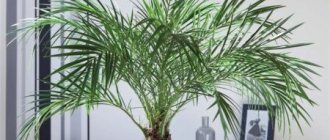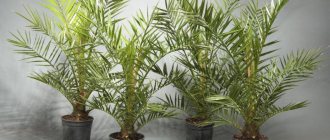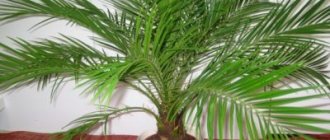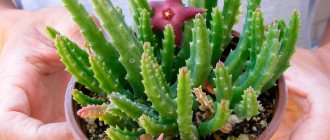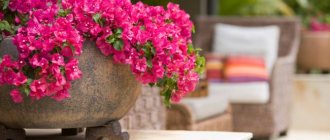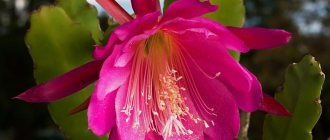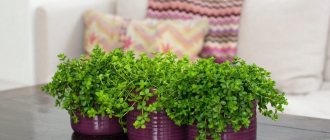Many people love dates. But many have tried them only as dried fruits, and not everyone has seen and tasted this exotic fruit fresh. A date tree can be grown in a garden plot or in an apartment. True, you won’t be able to expect fruit from it, but the plant is very decorative.
Types of date palms
Among the many types of date palms, it is worth noting those varieties that are used as home ornamental plants.
| View | Peculiarity | Differences in care |
| Palmate | The most common and fastest growing. Mature plants have a bare trunk. | You can grow it from the seeds of ordinary date fruits purchased in the store. |
| Robelena | Low growing and shade tolerant. Whitish coating on the leaves of young plants. Often - several trunks. | Requires intense lighting (12-14 hours a day), abundant watering and moist air. Heat-loving. |
| Canary | Short. Large, hard leaves with a bluish tint. The trunk is straight and thick. Thorns on leaf petioles. | Loves bright, well-ventilated rooms. Requires a large layer of drainage and a high pot. Easily propagated by seeds. |
| Curved | Multi-barreled. White fluff on the leaves. Thorns on petioles. Height up to 8 meters. | Resistant to direct sunlight, does not require shading. Loves moist air, requires frequent spraying. |
| Forest | The tallest, single-barreled. Thorns on petioles. The leaves, bluish with a gray tint, grow in groups of 3-4 pieces with a downward slope. | Unpretentious and resistant to pests. Frost-resistant. |
| Rocky | Single-barreled. Thorns on petioles. The leaves are small and few in number. | Frost-resistant. |
| Ceylonese | Single-barreled. Short bluish leaves with spines on the petioles. | Resistant to cold. |
The importance of culture in the homeland
The culture of ancient eastern Arab countries is closely associated with the cultivation of this tree. Many researchers, not without reason, believe that it was the date palm that contributed to the formation of the geographical relief of these territories. Such changes made it possible to survive in local climatic conditions.
This tropical desert culture is considered the founder of oasis agriculture. Thanks to its height and spreading top, it provided sufficient shade in which other crops that could not tolerate the scorching sun were grown.
The situation was well understood by local farmers, so they practically idolized the palm tree; for them it was a “nurse,” “oasis queen,” “tree of prosperity.” As for the fruits of the date palm, they were called “bread of the desert.” A person's wealth was then measured in the number of camels and date palms.
And today, the fruits of these trees are actively used as food by the local population; there are many oriental recipes in which fruits are the main or additional ingredients.
Caring for dates at home
The date is not a very fastidious plant, but a few simple conditions for caring for it at home must be observed.
Lighting
The palm tree loves bright rooms, but does not tolerate direct sunlight. To avoid leaf burns, it is necessary to provide shading. Covered balconies and loggias protected by curtains are good for growing dates.
Air temperature
The date is sensitive to temperatures, and if in summer it can withstand hot days, in winter it needs a cooler room - no higher than +18 ° C. Do not place the plant near radiators.
In the warm season, you can move the plant outside. But it should be borne in mind that at night the temperature should not drop below +12 °C.
Humidity
Since the palm tree comes from a tropical climate, it is accustomed to high air humidity. Therefore, the drier the air in the room and the higher the temperature, the more often the plant needs to be sprayed. In hot weather, large leaves can be carefully moistened with a wet cloth.
Watering
Palm trees do not tolerate stagnant water well, so a good layer of drainage is required at the bottom of the pot. For irrigation, settled water at room temperature is used, ideally rain or melt water.
The frequency depends on the time of year. In winter, dates require watering less often, and in summer - more often and more abundantly. At the same time, you need to monitor the condition of the soil, avoiding either waterlogging or drying out.
Top dressing
You can fertilize the soil every ten days in the summer and every month in the winter. To do this, 1 gram of potassium sulfur is added to a liter of water for irrigation.
Once a year, it is advisable to carefully remove the top layer of soil in the pot, replacing it with fresh soil mixed with superphosphate fertilizers.
Leaf trimming
It is necessary to promptly remove dried and broken leaves. It is not advisable to prune partially yellowed ones - they serve as a source of nutrients for the plant.
Transfer
A young date palm grows quickly and should be replanted at least once a year. For adult plants (over 5 years old), this procedure is required once every 3-5 years.
It is advisable to replant in the spring. It is strictly not recommended to choose autumn for this - the palm tree may die.
It has a hard time adapting to a new place, so it should be replanted in accordance with the step-by-step instructions:
- The new pot should be much deeper than the previous one, because the roots of the palm tree grow deeper than wide. Good drainage holes are a must.
- Place drainage at the bottom of the pot - for example, expanded clay.
- You can use ready-made store-bought soil or mix turf soil, sand and humus yourself in equal proportions, be sure to add 1 tablespoon of superphosphate fertilizers per 3 liters of soil.
- Under no circumstances should the earthen ball around the roots be damaged. Only the top layer of the former soil needs to be cleared off. If the pot does not allow you to remove the palm tree along with the soil, it should be broken or cut.
- The plant trunk does not need to be buried in a new pot. The ground level should remain the same as in the old place.
Reproduction
All types of dates are easily propagated by seeds, which can be purchased in stores. A regular palmate date can be grown from a seed from a candied fruit purchased at the supermarket.
Preparing the seeds
Immediately after extraction from the fruit or after purchase, the seeds are soaked in warm (+35...+40 °C) water for 2-3 days. The water changes every day.
For planting, select the seeds that have sunk to the bottom of the container. Before this, the swollen seeds are washed with running water.
Soil preparation
Drainage holes are cut in disposable cups. A sterile soil mixture is mixed, consisting of leaf soil, perlite and vermiculite in equal proportions. This mixture is poured into cups (not to the brim!) and poured over.
Landing
In order for the date to germinate faster, it is necessary to slightly open the outer shell of the pit. Then deepen the seed vertically into the ground (one for each cup) and sprinkle another half centimeter.
Care
Cups with seedlings are placed in a warm (+20...+30 °C) place and watered from time to time, preventing them from drying out. Germination takes three to nine months.
As soon as the first shoots appear, it is necessary to provide them with bright, diffused lighting - but in no case should they be placed in direct sunlight.
Transplantation into a pot is carried out when the length of the sprout reaches 4 centimeters.
General characteristics
You need to understand that, like any other fruit, dates have a season. It is from October to November that you can buy fresh dates, but the rest of the time - only dried ones.
However, do not be afraid of the second option, since the benefits of dried dates are also great. In addition, dried fruit is stored much longer.
Why don’t the beneficial properties disappear after the fruit is dried? The answer is simple. Dates are dried naturally with the help of the sun; various syrups are not used for this.
Proteins – 2.7%. Fats – 0.6%. The calorie content of this fruit is high - about 282 calories per 100 grams.
Advice! After eating dates, you should brush your teeth thoroughly!
Diseases and pests attacking dates
A well-cared for palm tree rarely gets sick. Here is a short list of diseases that dates are susceptible to and how to treat them.
| Cause | Signs on leaves | Treatment |
| Lack of nutrients | Yellowness. | Regular feeding. |
| Watering with hard water | Filtration of water for irrigation. | |
| Excessive watering | Brown, rotten smell. | Stop watering until the soil dries completely. |
| Lack of moisture | Darkening at the ends. | Correction of detention conditions, change of location. |
| Drafts | ||
| The air is too dry | ||
| Watering with cold water | ||
| Fungal diseases | Gray or pinkish spots. | Fungicides are antifungal drugs. It is not recommended to use more than once a week. |
In addition, the date palm can become the target of pest attack:
- The spider mite causes the leaves to turn yellow, dry out and curl, and entwine them with a thin web.
- Mealybugs suck the sap from the leaves, leaving a white, fluffy coating.
- Thrips contaminate and dehydrate, resulting in discolored spots.
- The scale insect attaches itself to the integument of the plant, drawing out the juice. It can be distinguished by its brown tubercles.
- Nematodes are worms that live inside leaves and cause them to thicken, deform and die. They are difficult to remove and spread quickly, so if they are detected, the plant should be destroyed along with the pot as quickly as possible.
Curved
Most insects can be removed using the following folk methods:
- Garlic infusion: 4 heads of garlic are dipped in 1 liter of water and kept for 5 days. The resulting extract is diluted with water and used to spray foliage.
- Tobacco infusion: add 40 grams of tobacco to 1 liter of water and leave for 2 days. Then add another liter of water and spray the plant.
- Soap-vodka solution: 15 g of liquid soap and a couple of tablespoons of vodka are diluted in 1 liter of water. Use once a week to wipe the leaves.
If the above methods are ineffective, it is necessary to treat the plant with agrochemicals, following the instructions.
It is recommended to first try the product on one leaf of the plant to determine the reaction.
Before processing, the soil must be covered with a film to protect it from foreign substances that could harm the composition of the soil.
Beneficial features
The range of beneficial properties of dates is extremely wide. These fruits are useful for constipation, intestinal disorders, cardiac problems, anemia, sexual dysfunction, diarrhea, bloating, and some types of cancer. Dates are also a healthy food for people with underweight, as well as for people with vitamin deficiency. These tasty fruits contain healthy fats, sulfur, calcium, iron, phosphorus, potassium, manganese, magnesium, copper, which are necessary for the full functioning of the body, from the cellular level to the functionality of all systems. Nutritionists recommend eating at least 1 date daily to maintain mineral and vitamin balance.
The nutritional value of Phoenix dactylifera fruits has made it one of the best foods for muscle growth, as well as recovery from illness or injury. Some studies have shown that these sweet fruits can prevent abdominal cancer. In Muslim countries, it is customary to end fasting by eating dates. Nutritionists say this is a good practice because it helps prevent overeating after long-term dietary restrictions. On the other hand, dates allow you to quickly restore your supply of minerals and vitamins. Due to their high potassium concentration, they are an extremely important product for the nervous system [5].
Possible problems during cultivation
Some gardeners are faced with a situation where a date stops growing for no apparent reason. This may happen due to the following factors:
- Lack of heat. At air temperatures below +17 °C, the roots of the plant cease to function properly, and the nutrients necessary for growth do not enter the trunk.
- Incorrect soil composition. The palm tree does not like soils with acidity below 7 pH. A lack of manganese and iron in the soil may also be to blame.
- Pot too big. The aboveground part of the plant will not grow until the roots fill all the available space.
Al-asila
Palm trees with this variety of dates grow on sandy and clay soil in Saudi Arabia. Al-Asila is very popular in the world; this particular fruit is very well exported. Palm trees are incredibly prolific, with about 200 kg of crop harvested from one tree. That is why such dates have a relatively low price, which has a positive effect on demand.
The length of the fruit is up to 5 cm, the weight is about 20 g, the color is coffee yellow. To use it in various dishes, it is first soaked and only then used in cooking.
Mr. Summer Resident informs: the use of date palms
In its natural habitat, the date palm is a very practical plant. Its fruits, which come to us as dried fruits, are rich in amino acids and are used not only for food, but also for medicinal purposes.
They also serve as food for animals. The date supplies people with wood, raw materials for textile production, valuable oil, and juice for extracting sugar.
Designers use this plant to fill empty spaces and zone rooms. It fits perfectly into an interior furnished in a modern style.
In esotericism, a date palm in the house is considered a sign of harmony in the family. She is credited with the ability to extinguish conflict situations and promote mutual understanding.

